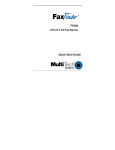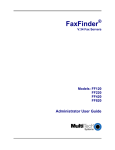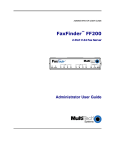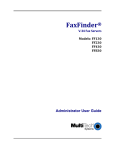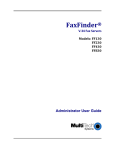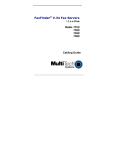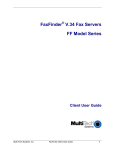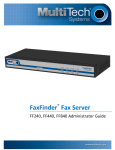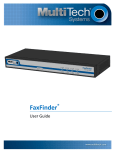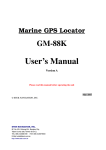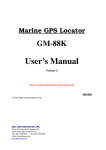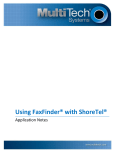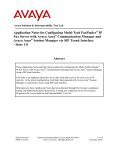Download Multitech FF110 User guide
Transcript
FaxFinder® Model FF110 V.34 Fax Server Quick Start Guide FaxFinder Model FF110 V.34 Fax Server Quick Start Guide P/N 82010272L, Revision C Copyright © 2006 by Multi-Tech Systems, Inc. All rights reserved. This publication may not be reproduced, in whole or in part, without prior expressed written permission from Multi-Tech Systems, Inc. Multi-Tech Systems, Inc. makes no representation or warranties with respect to the contents hereof and specifically disclaims any implied warranties of merchantability or fitness for any particular purpose. Furthermore, Multi-Tech Systems, Inc. reserves the right to revise this publication and to make changes from time to time in the content hereof without obligation of Multi-Tech Systems, Inc., to notify any person or organization of such revisions or changes. Record of Revisions Revision Date Description A B 02/12/04 01/21/05 C 05/12/06 Initial Release, Rev A. Updated tiff viewer drawings, added FFCF Manager info. Revise descriptions of Device Mgr SW and of client SW to rev level 1.06. Trademarks FaxFinder, Multi-Tech, and the Multi-Tech logo are trademarks of Multi-Tech Systems, Inc. All other brand and product names mentioned in this publication are trademarks or registered trademarks of their respective companies. GENERAL CONTACT Multi-Tech Systems, Inc. 2205 Woodale Drive Mounds View, Minnesota 55112, USA (763) 785-3500 (800) 328-9717 Fax: 763-785-9874 www.multitech.com TECHNICAL SUPPORT Country France India Europe, Asia, Africa U.S., Canada, All Others By E-mail support@ multitech.fr support@ multitechindia. com support@ multitech.co.uk By Phone (33) 1-64 61 09 81 (91) 1242340780 support@ multitech.com (800) 9722439; (763) 717-5863 2 (44) 118 959 7774 Contents GETTING STARTED............................................................................... 5 FRONT PANEL LEDS ................................................................................. 5 WE SUPPLY............................................................................................... 5 YOU SUPPLY ............................................................................................. 6 PREREQUISITE: ORDERING THE DID LINE ................................................ 7 SERVER INSTALLATION PROCESS .................................................. 8 PART A: CONNECTING THE FAXFINDER TO POWER OUTLET, PHONE LINES, AND ETHERNET ......................................................................................... 8 1. Connect FaxFinder to AC Outlet..................................................... 8 2. Connect FaxFinder to DID Line...................................................... 8 3. Connect FaxFinder to POTS Line ................................................... 9 4. Connect FaxFinder to Ethernet Network......................................... 9 5. Do Power-On Test ........................................................................... 9 PART B: CONFIGURING THE FAXFINDER SERVER ................................... 10 1. Setting Admin PC to Startup IP Address ....................................... 10 2. Logging In (I)................................................................................. 11 3. Setting FaxFinder IP Addresses .................................................... 11 4. Resetting Admin PC to Its Regular IP Address.............................. 12 5. Logging In (II) ............................................................................... 12 6. Setting Administrative Functions ................................................... 12 7. Setting Up the Mail Server............................................................. 15 8. Configuring the FaxFinder’s Inbound DID Modem...................... 16 9. Configuring the FaxFinder’s POTS Modem.................................. 18 10. Changing Admin’s Server Password ........................................... 21 11. Specifying Admin’s Client Password ........................................... 22 12. Sending Test Fax from Fax Machine to FaxFinder..................... 23 13. Assigning DID Numbers to Network Clients ............................... 25 CLIENT SOFTWARE INSTALLATION PROCESS ......................... 26 INSTALL FAXFINDER CLIENT SOFTWARE................................................ 26 ASSOCIATE CLIENT WITH SPECIFIC FAXFINDER UNIT(S) ........................ 27 MAKING ADDRESS BOOK ENTRIES ......................................................... 30 Making an Address Book by Direct Data Entry ................................ 30 3 Making Address Book Entries by Synchronization with Microsoft Outlook ...............................................................................................31 SEND TEST FAX .......................................................................................33 DEVICE MANAGER SOFTWARE FUNCTIONS ..............................34 INSTALLING DEVICE MANAGER SOFTWARE ............................................34 ADDING FAXFINDERS ..............................................................................36 SYNCHRONIZING PHONEBOOKS ...............................................................37 CLIENT OPERATION............................................................................40 SENDING A FAX (QUICK VERSION) ..........................................................40 SENDING A FAX (DETAILED VERSION) ....................................................42 SENDING A TEST FAX FROM FF CLIENT TO FAX MACHINE ......................48 RECEIVING A FAX ....................................................................................49 TECH SUPPORT .....................................................................................51 4 Multi-Tech FaxFinder Quick Start Getting Started Getting Started This guide shows you how to set up your Multi-Tech Model FF110 FaxFinder. Your FaxFinder is a complete, economical, easy-to-use network fax server. It allows you to receive faxes as emails and send faxes from any application that can print. Simply hook up a DID trunk and a regular POTS phone line, make an Ethernet connection to your LAN, and assign client email addresses to the DID numbers. Front Panel LEDs We Supply • An FF110 FaxFinder with factory-installed software • A set of four self-adhesive plastic feet • A power supply • One common telephone cable (RJ-11 at both ends) • One DID telephone cable (RJ-11 at one end; RJ12 at other end) • A product CD with software for client PCs, software for the administrator’s PC, and additional documentation for both administrators and client/users • This printed Quick Start Guide 5 Getting Started Multi-Tech FaxFinder Quick Start You Supply • A nearby AC power outlet • A nearby phone line jack • A connection to your Ethernet LAN • A nearby analog DID trunk line with a block of associated DID telephone numbers • A common subscriber phone line (POTS) • An administrative PC (with Windows NT, Windows 2000, or Windows XP as an operating system and with a web browser) to configure the FaxFinder unit and run the FaxFinder/CallFinder Manager software • Client PCs with email and printing applications. Client PCs on your network will receive faxes in their email inboxes. They will send faxes by printing to the FaxFinder server from application programs while running the FaxFinder client software. 6 Multi-Tech FaxFinder Quick Start Getting Started Prerequisite: Ordering the DID Line To operate the FaxFinder system, you will need a DID (Direct Inward Dial) line in your office. You must order the DID line from your local telephone operating company (telco). A DID line allows one phone line to be associated with multiple directory numbers. However, only one call can occur on this line at any given time. DID lines are sold in groups. For example, a telco in New York City might offer a DID line with a set of 20 directory numbers in the range of 212-555-4101 through 212-555-4120. When ordering your DID line, ask the telco representative for these details about the DID service. These details will be important when setting up your FF110 Fax Server. Parameter Value Required by Telco Number of digits used to designate the DID extension (usually 3, 4, 6, or 7) Type of “DID Start” used (wink, immediate, or delay dial) You will need this information to configure your FaxFinder Server (see step 8 on page 16). 7 Server Installation Multi-Tech FaxFinder Quick Start Server Installation Process Part A: Connecting the FaxFinder to Power Outlet, Phone Lines, and Ethernet Summary: Turn off your computer. Place the FaxFinder in a convenient location, and then connect it to your AC power outlet, DID line, POTS line, and Ethernet. 1. Connect FaxFinder to AC Outlet Make sure the FaxFinder’s power switch is OFF. Plug the DC power transformer into a power outlet or power strip. Plug the other end into the PWR jack on your FaxFinder. The DC power transformer is included with your FaxFinder. Caution: Use only the DC power transformer supplied with the FaxFinder. Use of any other transformer voids the warranty and can damage the FaxFinder. 2. Connect FaxFinder to DID Line Plug one end of the phone cable into the FaxFinder’s DID jack and the other end into an analog DID trunk line jack. The DID Line cable is included with your FaxFinder. Caution: The DID Line cable has an RJ11 connector on one end (this is the larger of the two connectors; it goes to the telephone wall receptacle). The DID Line cable has an RJ12 connector on the other end (this is the smaller connector; it goes to the DID Port on the FaxFinder unit). Never plug the DID connector into a standard POTS Line. This may damage the FaxFinder or the central office equipment. Use only an analog DID Line. 8 Multi-Tech FaxFinder Quick Start Server Installation 3. Connect FaxFinder to POTS Line Plug one end of the phone cable into the FaxFinder’s POTS jack and the other end into your standard telephone line jack. The POTS Line cable is included with your FaxFinder. 4. Connect FaxFinder to Ethernet Network. Plug one end of your RJ45 ethernet cable into the FaxFinder’s ethernet jack and the other end into your network ethernet hub. This ethernet cable is not included with your FaxFinder unit. Caution: Before connecting to the Ethernet Network, make sure that the network to which you are connecting the FaxFinder is not a 192.168.2.x subnet. If it is a 192.168.2.x subnet, connect from the Admin PC to the FaxFinder using an RJ45 crossover cable until the FaxFinder’s IP address has been configured. Thereafter, connect the FaxFinder into the network with an ordinary RJ45 cable. 5. Do Power-On Test Test your FaxFinder by turning it on (an on-off switch is located on the back panel). When you apply power, the FaxFinder performs a diagnostic self-test. The Status indicator flashes when the test is complete and the unit is ready. If this does not happen, check that the power switch is on, the power supply is solidly connected, and the AC outlet is live. 9 Server Installation Multi-Tech FaxFinder Quick Start Part B: Configuring the FaxFinder Server 1. Setting Admin PC to Startup IP Address a. Connect a pc to your network. b. Set the pc IP address to 192.168.2.x subnet (using any address excluding 192.168.2.1). Windows XP a. From the Windows desktop, right-click on “My Network Places,” and select “Properties.” b. In the Network Connection screen, right-click on “Local Area Connection.” c. In the Local Area Connection Properties screen, on the “General” tab, scroll to the “Internet Protocol (TCP/IP)” entry and select it. Click “Properties.” d. In the Internet Protocol (TCP/IP) Properties screen, record the existing IP address. Then reset the IP address to 192.168.2.2. Windows 2000 a. From the Windows desktop, rightclick on “My Network Places,” and select “Properties.” b. In the Network and Dialup Connections screen, right-click on “Local Area Connection” and select “Properties.” c. In the Local Area Connection Properties screen, select the “Internet Protocol (TCP/IP)” entry. Click “Properties.” d. In the Internet Protocol (TCP/IP) Properties screen, record the existing IP address. Then reset the IP address to 192.168.2.2. Windows NT a. From the Windows desktop, right-click on “Network Neighborhood,” and select “Properties.” b. In the Network screen, on the “Protocols” tab, select “TCP/IP Protocol” in the list of Network Protocols. Click “Properties.” c. In the Microsoft Internet Protocol (TCP/IP) Properties screen, record the existing IP address. Then reset the IP address to 192.168.2.2. 10 Multi-Tech FaxFinder Quick Start Server Installation 2. Logging In (I) a. Bring up a Web browser on your pc. At the browser’s address line, type the default Gateway address: http://192.168.2.1 and press Enter. b. The Login screen will appear. At this point you can be assured that the FaxFinder is connected to the network. If the Login screen does not appear, see item #1, “What if I can’t see the web page for my FaxFinder?” in the Troubleshooting section of the Administrator User Guide. c. At the Login screen, enter admin (all lower case) in the User Name field. d. Enter admin (all lower case) in the Password field. e. Click the Login button. The Web Management Home screen will appear. From this screen, you can access all of the FaxFinder Server software screens. 3. Setting FaxFinder IP Addresses a. In the FaxFinder Administration screen, go to the IP Configuration fields. Administration: IP Configuration IP Address 192.168.4.89 Subnet Mask 255.255.255.0 Name Server 192.168.11.251 Default Gateway 192.168.4.1 Secondary Name Server update b. Fill in the IP information that applies to your FF110 FaxFinder Server unit. The fields for “IP Address,” “Subnet Mask,” “Default Gateway” and “Name Server” are required. A “Secondary Name Server” may be considered optional. c. Click Update. 11 Server Installation Multi-Tech FaxFinder Quick Start 4. Resetting Admin PC to Its Regular IP Address In step #1 above, you recorded the original IP address of the administrator’s PC and then reset it to the IP address required to allow communication with the FaxFinder unit. You must now set the IP address of the administrator’s PC back to its original value. 5. Logging In (II) Having reset the IP address of the administrator’s PC, you must log into the FaxFinder Server software again. Go to the Login screen, enter admin as User Name and admin as Password. 6. Setting Administrative Functions Go to the FaxFinder Phone Book screen. Phone Book Name User ID Email Address Ext Ad mini strator a dmin Function update update update update update update update POTS Li ne D ead L etter Box delete delete delete delete add a. General Admin Email Address & DID i. ii. In the “admin” row of the Phone Book screen, enter the name and user ID to be used for the FaxFinder administrator. All incoming faxes will be marked as coming from this administrator. Then enter the email address of the party who will act as the FaxFinder administrator. Click on Update in the “admin” row. At this point, a Login screen will appear and you will be asked to log in again. Log in using the administrator’s User ID (as listed in the “User ID” column) and the administrator’s current password (at this point, it should be admin). 12 Multi-Tech FaxFinder Quick Start Server Installation The message “Success: [name] was updated” will appear above the Phone Book list. Phone Book Name User ID Email Address Ext H ank Gre gory -- Admi n a dmin hg [email protected] POTS Li ne D ead Le tter Box Function update update update update update update update delete delete delete delete add b. Destination Email Address for POTS Line Fax i. ii. In the “POTS Line” row of the Phone Book screen, enter the email address of the person whom you want to receive all inbound faxes received on the POTS line. (The POTS line is primarily for sending faxes but can receive faxes, as well. Typically, faxes coming in on the POTS Line are sent to the FaxFinder Administrator.) Click on Update in the “POTS Line” row. The message “Success: POTS Line was updated” will appear above the Phone Book list. Phone Book Name User ID Email Address Ext H ank Gre gory -- Admi n a dmin POTS Li ne D ead Le tter Box hg [email protected] hg [email protected] Function update update update update update update update add 13 delete delete delete delete Server Installation Multi-Tech FaxFinder Quick Start c. Destination Email Address for Unassigned DID Numbers i. ii. In the “Dead Letter Box” row of the Phone Book screen, enter the email address of the person whom you want to receive all inbound faxes sent to unassigned DID phone numbers. (For example, a company might obtain a group of 20 DID phone numbers but only use 17, retaining 3 for future use. Any faxes sent to the three unused DID numbers would go to the Dead Letter Box. Typically, Dead Letter Box items are sent to the FaxFinder Administrator.) Click on Update in the “Dead Letter Box” row. The message “Success: Dead Letter Box was updated” will appear above the Phone Book list. Phone Book Name Ha nk Greg ory -- Admin POTS Lin e De ad Letter Box User ID Email Address Ex t ad min hgg @rmc8 3.com hgg @rmc8 3.com hgg @rmc83.com Function update update update update update update update delete delete delete delete add d. Personal Email Address for Admin i. Just below the “Dead Letter Box” row of the Phone Book screen, enter the name and user ID to be used to receive the FaxFinder administrator’s individual inbound faxes. (Generally, the administrator should have an additional phonebook entry for receiving ordinary fax traffic for his/her own use that is separate from the administrator function.) Then enter the email address at which the FaxFinder administrator will receive such fax traffic. 14 Multi-Tech FaxFinder Quick Start ii. Server Installation Click on Update for this row. The message “Success: [name] was updated” will appear above the Phone Book list. 7. Setting Up the Mail Server The FaxFinder uses a mail server to send fax log reports, by email, to the administrator. An email is also sent to the administrator each time the FaxFinder is powered up. In all cases, you must specify the address of the mail server and the email address of the administrator. Some email servers require authentication before allowing the FaxFinder access. In these cases, the FaxFinder unit must be assigned a Server User ID and a password. If the mail server does not require authentication, the related SMTP Configuration fields (“SMTP Server User ID,” “SMTP Password,” and “Retype SMTP Password”) must be left blank. a. In the FaxFinder Administration screen, go to the SMTP Configuration fields. b. Fill in the network IP address or domain name of your mail server. c. Enter the email address of the administrator (the party that you want to receive fax log reports). d. At this point the Administrator should receive an email from your FaxFinder saying that the mail server address has been updated. 15 Server Installation Multi-Tech FaxFinder Quick Start e. Email Server Authentication Parameters. If your email server requires authentication in order to give the FaxFinder access, fill in the three related SMTP fields (SMTP Server User ID, SMTP Password, Retype SMTP Password). If you can enter the network email program and send messages without entering a User ID and Password, then you must leave these fields blank. However, if your network email program does require a User ID and Password in order to send email messages, you must fill in these three fields. If authentication is required and these fields are left blank, then the error “SMTP Authentication Error” will appear on the Current Status screen in the “Email Status” field. If authentication is not required and these fields are filled in, then an error will also occur. You must know how your email server works in this regard and complete the Administration: SMTP Configuration screen accordingly. f. If you do not receive an email saying that the mail server address has been updated, see item #2 “What if I don’t get an email when I set the mail server address?” in the Troubleshooting section of the Administrator User Guide. 8. Configuring the FaxFinder’s Inbound DID Modem The FaxFinder’s DID Modem directs inbound faxes to client email addresses. a. In the FaxFinder Server software, go to the Modem Configuration screen. 16 Multi-Tech FaxFinder Quick Start Server Installation b. Under Modem Configuration: Modem 1 (DID Modem), enter the values that match the characteristics of your DID phone line in the fields provided. (See the section “Prerequisite: Ordering the DID Line” on page 7.) c. Note that the value entered in the “Fax ID” field (typically the DID phone number and, sometimes, an organizational identifier) will appear in the fax log printed by the sender’s fax machine. d. Polarity. This refers to DID battery polarity. This parameter must be set (and possibly re-set, as needed) on a trial-and-error basis. Signs of incorrect polarity: (1) outside party originating call to DID number gets immediatebusy signal after dialing; (2) line suddenly disconnects just a call should go through. e. Click Update. f. Open the FaxFinder Server Home screen. Click on Current Status. Watch the Current Status: DID Modem portion of the screen. The “State” of the DID Modem (see Current Status: DID Modem screen) should be “Waiting for Ring.” 17 Server Installation Multi-Tech FaxFinder Quick Start g. From an ordinary POTS phone, dial one of the DID phone numbers that is active in the system. Dial the DID phone number as you would from an outside line (it will not work to dial the number as if it were an ordinary 3- or 4-digit extension). h. In the Current Status: DID Modem screen, the "State" field should change to "Waiting for Connect." On the phone, you should hear modem dialup/negotiation tones. i. If you observe both the "Waiting for Connect" state and hear the tones, then the FaxFinder's DID Modem has been configured properly. If either of these is absent, see item #3 “What if the modem doesn’t answer a call on the DID line?” in the “Troubleshooting” section of the Administrator User Guide. 9. Configuring the FaxFinder’s POTS Modem The FaxFinder’s POTS Modem directs outbound faxes sent by clients into the public phone system. This POTS modem can also receive faxes but that is a secondary function. All faxes coming in on the POTS modem must go to the same email address to be specified in the Phone Book screen. a. In the FaxFinder Server software, go to the Modem Configuration screen. b. Under Modem Configuration: POTS Modem 2, enter the settings with which you want to operate the FaxFinder’s outbound POTS modem. The default values have been designed to work well in many situations. 18 Multi-Tech FaxFinder Quick Start Server Installation c. Dial Prefix (or ‘access digit’). When the FaxFinder is attached to an extension of a PBX or key phone system, an access digit is often required to ‘get an outside line’ (that is, to make a connection to the PSTN). Often a “9” or an “8” is used for this purpose. You can also add a comma (“,”) to insert a pause that may be required to receive dial tone for the outside line. If needed, enter the access digit and optional comma in the “Dial prefix” field. Inform FaxFinder client users that they should not insert any access digits when entering fax numbers in the FaxFinder Send Fax screen or in their FaxFinder Address Books. Instead, client users should enter fax numbers the way they would dial the number from an ordinary residential phone line. Finally, avoid any access digit combination that might predispose client users to make fax calls accidentally to 911 or any other official/emergency phone number. d. Fax ID. The value that you specify in the “Fax ID” field will be printed at the top of each page of the transmitted fax. This is usually the phone number of the line to which the POTS modem is attached. Sometimes company names or abbreviations are included in this text string. Some governments (including 19 Server Installation Multi-Tech FaxFinder Quick Start U.S.A.) require that the originating phone number be printed on each fax page. The value entered in the “Fax ID” field will appear in the fax log printed by the sender’s fax machine and, typically, will be printed at the top of each page of the transmitted fax. e. Smart Dial. When Smart Dial mode is ON, the FaxFinder will look for a dial tone before dialing. If, under normal circumstances, no dial tone is presented to the FaxFinder, then set Smart Dial to OFF. When Smart Dial is OFF, the FaxFinder modem will seize the phone line and dial after a 3-second pause whether a dial tone is present or not. Hint: If ‘no dial tone’ messages appear consistently, set Smart Dial to OFF. f. Click Update. Phone Book Name User ID E mail Address DID# Han k Grego ry - Admin a dmin POTS Li ne Dea d Letter Bo x Han k Grego ry hg [email protected] hg [email protected] hg [email protected] h ank hgg @rmc83.com 242 6 Function update update update update update update update delete delete delete delete add g. Click on Current Status. Watch the Current Status: POTS Modem 2 portion of the screen. The “State” of the POTS Modem should be “Waiting for Ring.” h.Test Call.. From a different POTS phone, dial the number of the POTS phone line to which the FaxFinder is attached. i. In the Current Status: POTS Modem 2 screen, the "State" field should change to "Waiting for Connect." On the phone, you should hear modem dialup/negotiation tones. 20 Multi-Tech FaxFinder Quick Start Server Installation j. If you both observe the "Waiting for Connect" state and hear the tones, then the FaxFinder's Modem has been configured properly. If either of these is absent, see item #3 “What if the FaxFinder doesn’t answer a fax call?” in the “Troubleshooting” chapter of the Administrator User Guide. 10. Changing Admin’s Server Password a. In the Password Administration screen, enter a new User ID and Password for the FaxFinder Administrator (something other than “admin” and “admin”). This User ID and password are to be used in that person’s capacity as administrator. Then reenter the password in the “Confirm Password” field. Passwords can be as short as 1 character, as long as 40 characters, and are case-sensitive. Use a password that is non-obvious and that cannot be guessed easily. 21 Server Installation Multi-Tech FaxFinder Quick Start b. Click on Update for this row. The Login screen will appear. Passw ord Administration Name Han k Grego ry - Admin Han k Grego ry User ID Password a dmin-h ank h ank *** ** Confirm Password Function * *** * update update 11. Specifying Admin’s Client Password a. In the Password Administration screen, enter a new User ID and Password for the FaxFinder Administrator to be used in that person’s capacity as client/user of the FaxFinder system. Then re-enter the password in the “Confirm Password” field. Passwords must be at least 4 characters in length, can be as long as 12 characters, and are case-sensitive. Use a password that is non-obvious and that cannot be guessed easily by others. b. Click on Update for this row. Passw ord Administration Name Han k Grego ry - Admin Han k Grego ry User ID Password a dmin-h ank h ank *** ** Confirm Password Function * *** * 22 update update Multi-Tech FaxFinder Quick Start Server Installation 12. Sending Test Fax from Fax Machine to FaxFinder a. Using a conventional fax machine, send a fax to the DID fax number established for the FaxFinder Administrator. b. Verify that the fax message sent reaches the email inbox of the administrator. Allow time for the fax to arrive as an email message. Arrival time will depend on your circumstances (the page count of the message, how often email is delivered, etc.). If the email does not appear within a reasonable period of time, see the “Troubleshooting” chapter of the Administrator User Guide, specifically the item entitled “What if I don’t get the email to me of the test fax that I sent?” 23 Server Installation Multi-Tech FaxFinder Quick Start c. Verify also that you can open the fax in a Tiff viewer program on your computer. The viewer program you use could be either the Multi-Tech Tiff Viewer or a graphic file viewer included with or installed in your PC. (The Multi-Tech Tiff viewer is included on the Product CD and installed with other client programs. During installation, you can choose to associate all Tiff files with the Multi-Tech Tiff Viewer or with another program.) In your email program, double-click on the file attached to the email message. The Tiff viewer program will come up automatically displaying the tiff file of the fax. 24 Multi-Tech FaxFinder Quick Start Server Installation 13. Assigning DID Numbers to Network Clients a. In the Phone Book screen just below the entries for the FaxFinder administrator, make phonebook entries for the other persons in your office to whom DID fax numbers have been assigned. For each such FaxFinder client/user, enter the name, user ID, email address, and DID extension in the appropriate fields. b. Click on Add for this row. The message “Success: [name] was updated” will appear above the Phone Book list. Phone Book Name User ID E mail Address DID# H ank Gre gory -- Admi n a dmin hg [email protected] H ank Gre gory h ank hg [email protected] 242 6 Jo hn Schli ef j ohns jsch [email protected] 242 7 R oge r She rman Gus Schmi dt ro ger g rs rog [email protected] grs@rmc83 .com 242 8 242 9 POTS Li ne D ead L etter Box hg [email protected] hg [email protected] Function update update update update update update update add 25 delete delete delete delete Client Installation Multi-Tech FaxFinder Quick Start Client Software Installation Process Install FaxFinder Client Software NOTE: The FaxFinder client software must be installed on each computer by a user with administrative rights on that computer. 1. At the client PC, launch the installation program by clicking on the setup.exe file on the FaxFinder Product CD. Transient screens will appear. 2. At the Welcome screen, click Next. 3. At the Choose Destination Location screen, designate the desired file location for the FaxFinder client software. In most cases, the default file location is recommended. Specify the desired file location and click Next. 4. At the Select Program Folder screen, you can designate a program folder for the FaxFinder software. Again, in most cases, the default is recommended unless you have other plans. Designate a folder and click Next. 5. A transient screen will appear while files are being copied. 6. You will be asked whether or not you want to associate TIF and CPG files with the FaxFinder viewer. Click Yes. 7. If a Question screen appears asking “Warning – the extension CPG is already registered. Overwrite?” Click Yes. 8 If a Question screen appears asking "Warning - the extension TIF is already registered, Overwrite?,” you must respond. Click Yes if you wish to use the TIFF viewer installed with the FaxFinder Client Software. Click No if you prefer to use a different software package for viewing TIF files. 9. Then the ‘completion’ screen will appear. Click Finish. 26 Multi-Tech FaxFinder Quick Start Client Installation 10. Icons for the FaxFinder software applications will appear in the Windows Start menu. A FaxFinder icon will also appear in the tray area at the lower-right corner of the screen. Associate Client with Specific FaxFinder Unit(s) 1. At the main screen of the FaxFinder Fax Client Software, click on Edit and select “Add Fax Server.” 27 Client Installation Multi-Tech FaxFinder Quick Start 2. At the Add Device Address screen, in the “Select Server” field, highlight “FaxFinder.” In the “Enter Address” field, enter the IP address or domain name of the FaxFinder unit that the client will use. A client can be associated with more than one FaxFinder unit, but the associations must be established one at a time. 28 Multi-Tech FaxFinder Quick Start Client Installation 3. Enter, in the appropriate fields, the Username and Password that the client will use when accessing this FaxFinder unit. (The Username in the FaxFinder client software is the same as the User ID in the FaxFinder server software.) If the client is to be associated with multiple FaxFinder units, a different Username and Password could be established for each. However, in most cases, it is advisable (for the sake of simplicity and convenience) to use the same Username and Password for all FaxFinder units. Click OK. 4. A new FaxFinder entry should appear on the “Device Status” tab of the FaxFinder Fax Client Software screen. The status of the newly registered FaxFinder unit should momentarily go from “Logging in” to “Idle.” If it goes to Login Failure, then one of two things is wrong: a. The IP address or domain name is wrong. If that is the case, delete that entry (by right click-DELETE), and enter a new one; otherwise, b. The Username/Password combination may be wrong. Verify that the Username/Password combination in the client software screen matches the UserID/Password combination established in the FaxFinder Server software screen. 29 Client Installation Multi-Tech FaxFinder Quick Start Making Address Book Entries The Address Book in the FaxFinder Fax Client software is a list of persons to whom you expect to send faxes frequently. It is a kind of “outbound list” or recipient list for faxing. You can create your Address Book either by direct data entry (using the Add Contact command in the Edit menu) or, if your PC uses Microsoft Outlook as an email client program, by synchronizing your FaxFinder Address Book with a folder in Microsoft Outlook that already contains fax numbers. This synchronization process will alter both the FaxFinder Client Address Book and the Outlook folder. Making an Address Book by Direct Data Entry 1. In the FaxFinder Fax Client Software, go to Edit | Add Contact. 2. Fill in a Name and Fax Number for the recipient and specify other fields as needed. Click OK. 30 Multi-Tech FaxFinder Quick Start Client Installation Making Address Book Entries by Synchronization with Microsoft Outlook 1. In Microsoft Outlook, view the folder from which you want to be able to transfer fax numbers to the the FaxFinder Client Address Book. Confirm that you want those entries in your FaxFinder Client Address Book. If so, proceed. (For example, you might select the “Contacts” folder in Outlook as your source of existing fax numbers). 2. In the FaxFinder Fax Client Software, go to File | Options |Advanced and click on “Enable Outlook Sync.” 31 Client Installation Multi-Tech FaxFinder Quick Start 3. Click on Browse. Select the desired folder from the Select Contact Folder (Outlook:) screen. Click OK. If a confirmation screen appears, click OK. At the Options screen, click OK. 4. In the FaxFinder Fax Client Software, go to the Device Status tab and select Outlook Synchronizer in the “Device” list. 32 Multi-Tech FaxFinder Quick Start Client Installation 5. Right-click on Outlook Synchronizer and select Synchronize with Outlook. The Outlook Contact information will be copied into the FaxFinder Address Book. Entries from the FaxFinder Address Book (if any) will also be copied into the Outlook Contact list. A relationship will be created between the corresponding entries for future synchronizations. The Outlook Synchronizer feature has many options. For further details, see the Administrator User Guide. Send Test Fax To verify that the software installation has succeeded, you should use the FaxFinder client software to send a fax to a regular fax machine (preferrably a local fax machine). To do so, follow the instructions for the “Sending a Fax” procedure below. 33 Device Manager Multi-Tech FaxFinder Quick Start Device Manager Software Functions The Device Manager software lets you control multiple CallFinder units as a system. It is typical to install the Device Manager program on the administrator’s computer (Windows operating system required). When deploying a new system, two commands will be particularly useful: Add Device and Synchronize Phonebooks. These Device Manager commands are described after the installation process. Installing Device Manager Software 34 Multi-Tech FaxFinder Quick Start Device Manager Installation (continued) The Device Manager installation is complete. 35 Device Manager Device Manager Multi-Tech FaxFinder Quick Start Adding FaxFinders Any FaxFinder unit to be added to the system and come under the management of the Device Manager software must be connected to the same IP network as the computer running the Device Manager software. To add a FaxFinder to the system, start at the main Device Manager screen. Open the Edit menu and select Add Device. When the Add Device Address screen appears, enter the IP address, Username, and Password for the unit you are adding to the system. Then click OK. 36 Multi-Tech FaxFinder Quick Start Device Manager Synchronizing Phonebooks To synchronize phonebooks is to cause the list of allowable inbound fax recipients on one FaxFinder server to be the same as that on another FaxFinder server. Both FaxFinder servers must be connected to the same Ethernet network. When FaxFinder phonebooks are synchronized, all non-administrative listings match. One FaxFinder unit (the Primary unit) holds the master list that is transmitted (using the Synchronize Phonebooks command) to other FaxFinder units in the system (Copy units). FaxFinder units can operate in same system but have independent phonebooks, in which case they are designated Independent. Synchronizing phonebooks entails three steps: 1. Designating one FaxFinder as the master phone book. In the main Device Manager screen, right-click on the unit to be designated as master, scroll to Set Phone Book Sharing, and select Primary. 37 Device Manager Multi-Tech FaxFinder Quick Start 2. Designating all other FaxFinder units participating in phonebook sharing as Copy units. In the main Device Manager screen, rightclick on each unit to share the master phonebook, and select Copy. 3. Invoking synchronization. In the main Device Manager screen, open the Edit menu and select Synchronize Phonebooks. The Synchronize Phone Books screen will appear along with a series of transient screens (denoting tftp data transfers) and confirmation screens (where you click OK to proceed). 38 Multi-Tech FaxFinder Quick Start Device Manager After the master phonebook has been transferred to the first Copy FaxFinder (or CallFinder) unit and that unit has been rebooted, the Device Manager will automatically begin synchronizing the additional Copy FaxFinder (or CallFinder) unit in the system (if any) until all have been synchronized. 39 Multi-Tech FaxFinder Quick Start Client Operation To see the newly synchronized phonebook list in each Copy FaxFinder unit, you must update the Phone Book screen by clicking on the Phone Book button (to the right of Administration) in the list at the top of the screen. Client Operation Sending a Fax (Quick Version) 1. At the application program on which your source message has been written or drawn (typically in a word processor or graphics program), print to FaxFinder. Wait a few seconds for the FaxFinder Send Fax screen to appear. 40 Multi-Tech FaxFinder Quick Start Client Operation 2. At the FaxFinder Send Fax screen: A. Enter the recipient’s name and faxing phone number in the “Name” and “Phone Number” fields. (Add prefix 9 if needed.) B. Click Add Recipient. C. Click No when asked “Would you like to add the recipient to the address book?” No forestalls the screens needed to make an Address Book entry. (Clicking Yes, however, will be useful if you expect to send more faxes to that party later.) NOTE: If you want to add a cover page and/or preview the fax, skip to Options before sending. D. Click Send Fax. Options. Use Cover Page. Enter subject and cover page notes. Cover Page Style. Choose style from drop-down menu. View/Edit cover-page style. Preview Fax to see entire message before sending. 41 Client Operation Multi-Tech FaxFinder Quick Start Sending a Fax (Detailed Version) To send a fax by printing from an application program on a client PC, follow the steps listed below. 1. The client PC and the FaxFinder server must both be connected to the same Ethernet LAN system. (See the section “Part B: Configuring the FaxFinder Server” earlier in this manual.) 2. The FaxFinder client software must be installed on the PC. (See the section “Installing FaxFinder Client Software” earlier in this manual.) 3. After installation, the FaxFinder Fax Client Software program will be running whenever the PC is on. You can view the FaxFinder program's main window by clicking on the FaxFinder icon at the lower right of the PC’s monitor screen in its Application Tray -- and then selecting “Show FaxFinder Client Software.” Note: Normally, the user can shut down the FaxFinder program by selecting "exit" either from the tray icon or from the main FaxFinder program screen. If the program has been shut down, it can be restarted from the Windows Start menu. 42 Multi-Tech FaxFinder Quick Start Client Operation However, you can send faxes through the FaxFinder without bringing up the FaxFinder Fax Client Software screen. 43 Client Operation Multi-Tech FaxFinder Quick Start 4. At the application program (for example, a word processing program or drawing program), print to the FaxFinder. Setting the destination of the printing job varies from program to program. For the common Notepad text editor program, for example, you must set the destination printer in the Page Setup screen. In most cases, however, the destination printer can be set in a Print menu that appears when each printing job is initiated. 44 Multi-Tech FaxFinder Quick Start Client Operation 5. After the printing has been initiated by the application program, the FaxFinder Send Fax screen will appear. Click on Address Book. When the Address Book screen appears, click “Add.” At the New Contact screen, enter the recipient’s name, fax number, and any other contact information you want to retain. 45 Client Operation Multi-Tech FaxFinder Quick Start The recipient’s fax number should be entered as you would dial it from a phone on the public phone network (as from a residential phone). Click OK. At the Address Book screen, highlight the recipient in the list and click “Select.” The party will appear in the “Recipients” list in the FaxFinder Send Fax screen. Additional recipients can be added. The same fax message will be sent to all recipients. A recipient can also be specified directly in the FaxFinder SendFax screen by typing his/her name in the “Name” field, typing his/her fax number in the “Phone Number” field, and then clicking on “Add Recipient.” Recipients specified in this way will not be added to the Address Book. You can also access the Address Book directly to add and edit entries. At the FaxFinder Fax Client Software screen, go to Edit | Add Contact. 6. If you want to include a cover page with your fax, click in the “Use Cover Page” checkbox. Enter information as needed in the “Subject” and “Cover Page Notes” fields. Automated fields, like sender information (individual name, company name, street address, phone number, fax number, etc.) should be entered in the Address Book. The Address Book is accessible in the “Options” menu of the FaxFinder Fax Client Software screen. For more information about addresses and the automated fields used in cover pages, see the Client User Guide. 46 Multi-Tech FaxFinder Quick Start Client Operation The “Cover Page Style” chosen will determine how this information will appear on the fax cover page. You can select a standard style from the “Cover Page Style” drop-down menu or create a style of your own in the Template Editor. To access the Template Editor software, click on the “View/Edit” button. (For more information, see the section “Creating or Modifying Cover Page Styles” in the Client User Guide.) Click on the “Preview Fax” button to check the fax before you send it. The Mult-Tech Tiff Viewer program will appear. In it, you can view both the cover page and the main fax page(s). (For more information on this, see the section “Using the Multi-Tech Tiff Viewer” in the Client User Guide.) When satisfied with your fax, close the Multi-Tech Tiff Viewer program and return to the FaxFinder Send Fax screen. 7. At the FaxFinder Send Fax screen, click on the “Send Fax Now” button to send the fax. 47 Client Operation Multi-Tech FaxFinder Quick Start 8. Confirmation of having sent the fax(es) successfully will appear in the “Fax Log” tab of the FaxFinder Fax Client Software screen. Sending a Test Fax from FF Client to Fax Machine To confirm that the FaxFinder client software is working properly, identify a fax machine to which you can send a test fax. Ideally, the fax machine should be in or near your own office. Then, using some convenient application program, send a fax to that fax machine by printing to the FaxFinder from the application program. Follow the instructions given in the “Sending a Fax” section above. For example, you might fax a text document by using the Print command in MSWord, WordPerfect, or Notepad. After the FaxFinder has been installed, a new ‘printing’ destination will appear in the Print menu in the other application programs on your PC. 48 Multi-Tech FaxFinder Quick Start Client Operation Receiving a Fax The FaxFinder Server delivers incoming faxes to client PCs in their email inboxes. 1. A DID phone directory number must be assigned to the client PC at the FaxFinder Server. 2. The client PC and the FaxFinder server must both be connnected to the same Ethernet LAN system. (See the section “Part B: Connecting the FaxFinder to your Network” earlier in this manual.) 3. Some sender faxes a document to a FaxFinder client using that client’s DID phone number. 4. The incoming fax arrives in the client’s email inbox as a message with an attachment. The email message is marked as being from the FaxFinder Administrator. The sender’s “Remote ID” and the client’s name appear in the “Subject” line of the email message. (The Remote ID comes from the sending fax machine and is typically the sender’s fax number or name.) 49 Client Operation Multi-Tech FaxFinder Quick Start 5. The FaxFinder client opens the email message. The incoming fax message takes the form of a graphic file attachment. The FaxFinder Server has assigned the file an automatic file name. 50 Multi-Tech FaxFinder Quick Start Client Operation 6. The FaxFinder client can open or save the file. a. Opening the fax message graphic file. Incoming fax messages are TIFF files. These TIFF files are automatically associated with the Multi-Tech Tiff Viewer program or with another chosen viewer. The client can open the fax email attachment directly in the viewer program. b. Saving the fax message graphic file. The client can save the fax file. The file name and directory location are determined automatically. 7. The client views the fax message in the viewer program and/or prints a paper copy. Tech Support Please direct your questions regarding technical matters, product configuration, verification that the product is defective, etc., to our Technical Support department at the phone number or email address for your geographic location, as listed on page 2. Product support resources are available at the Multi-Tech web site: www.multitech.com. 51 Patents This device is covered by one or more of the following patents: 6,031,867; 6,012,113; 6,009,082; 5,905,794; 5,864,560; 5,815,567; 5,815,503; 5,812,534; 5,809,068; 5,790,532; 5,764,628; 5,764,627; 5,754,589; D394,250; 5,724,356; 5,673,268; 5,673,257; 5,644,594; 5,628,030; 5,619,508; 5,617,423; 5,600,649; 5,592,586; 5,577,041; 5,574,725; D374,222; 5,559,793; 5,546,448; 5,546,395; 5,535,204; 5,500,859; 5,471,470; 5,463,616; 5,453,986; 5,452,289; 5,450,425; D361,764; D355,658; D355,653; D353,598; D353,144; 5,355,365; 5,309,562; 5,301,274. Other patents pending. 82010272L




















































